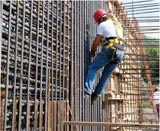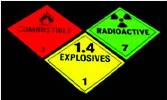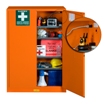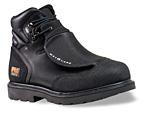
July 2012
- FOOT PROTECTION: Gaining Traction on Program Success
- HEAD PROTECTION: Three Keys: Safety, Performance, Comfort
- FALL PROTECTION: OSHA's New Fall Protection Directive for Residential Construction
- OIL & GAS SAFETY: Moving Away from Hard-Wired
- OIL & GAS SAFETY: Trends in Monitoring H2S Hazards
- 80TH ANNIVERSARY ISSUE: A Legacy of Service
- TRAINING: What Did You Say?
- DISTANCE LEARNING: Breaking Down the Barriers to Effective Learning
- TRANSPORTATION SAFETY: Back to the BASICs
- FACILITY MANAGEMENT: Routine Safety Audits Pay Dividends
- FACILITY MANAGEMENT: Storage: Vital to Emergency Preparedness
- FACILITY MANAGEMENT: Shining a New Light on Safety
- RUGGED COMPUTING: Top-Flight Tablets
- SAFETY MANAGEMENT: Using Advanced Analytics to Predict and Prevent Workplace Injuries
- SOFTWARE: Keeping Pace with EHS Compliance Management
- SOFTWARE: The Critical Role of Data in Effective Safety Programs
Click here to subscribe.
Cover Story

By Ronnie Rittenberry, Jerry Laws
From its inception in the Great Depression to today's recession, this publication has been a continual resource for worker protection.
Features
By Philip A. Leinbach, Joshua Manuel
Fork trucks were constantly driving in and out of the aisle. Fork truck traffic in the aisle and dock area was especially heavy during peak packaging runs.
By Elizabeth James
Today's "distance education" can be achieved from virtually anywhere and any time in the world in multiple formats.
By Yan Banducci
Wireless gas sensor systems make it safer to explore for oil and gas.

By Ryan Barnett
FMCSA is providing added reason to tackle these problems before they appear: Drivers will be cited if an inspection turns up any safety violations.

By Keith Rhodes
We’ve seen an increase in the overall quality of systems that are more reliable, robust, and require much less maintenance.

By John Sacht
Photoluminescent technology provides a new level of safety, as well as egress lighting.

By Marc Harkins, Trish Luedtke
The required compliance deadline will now go into effect Sept. 15, 2012.
By John Easton
An effective safety/environmental compliance management program cannot be executed without well-managed, accessible, and dynamic data.

By Fred Ravetto
The adjustability of hard hats has come a long way since their invention in 1919.

By Griffin Schultz
Only observation data are required for the model to work.

By Mary Anne Gunn
A Swiss air rescue service enhanced its documentation efficiency and improved flight conditions by adopting new tablet PCs.

By Mike Baldwin
Pieper was troubled by a recurring problem: The hospital was in dire need of places to store and deploy emergency supplies and equipment.

By Keith Bilger
The job safety analysis (JSA) performed for each particular job function will best determine what is needed in a safety shoe -- or if a safety shoe is needed at all.
By Randy DeVaul
Cross-cultural communication entails body language, verbal tone, and at least a minimal understanding of why people act and say what they do.
By Ben Archibald
It is time to put the traditional challenges faced by safety programs behind us.
Departments
By Robert Pater
Wanting, wishing, and pressuring gets only so far without the needed skills to make desired improvements.
By Shawn M. Galloway
Success goals and progress indicators that show movement toward continuous improvement sends the message we are getting better, rather than failing less.